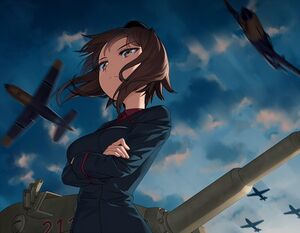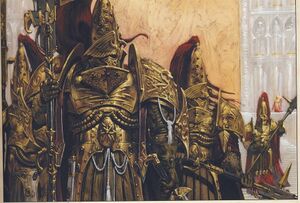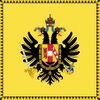Imperial & Federal Common Army
| R.u.B Gemeinsame Armee | |
|---|---|
| Country | |
| Branch | Army |
| Type | Army |
| Role | Planetary Control and Invasion |
| Motto(s) | "Gott mitt uns" |
| March | Regimental Salute March |
| Commanders | |
| Commander-in-Chief | Emperor Karl Franz II |
| Chancellor of the Army | Chancellor Franz-Josef von Wittelsbach |
| Chief of the General Staff | Field Marshal Nicole Lawson |
| Insignia | |
| Imperial Standard | |
The Imperial & Federal Common Army (R.u.B Gemeinsame Armee) consists of the majority of land forces available to the Imperial & Federal Union, and is intended to perform the primary duties of planetary defence, invasion, and control. The Common Army is the second largest of the three force considered to be a part of the Kaiserliche Wehrmacht, primarily due to the fact that the Navy has remained the centrepiece of Imperial & Federal Union defense structure as a whole. However, unlike the Imperial & Federal Navy, the Common Army is intended to receive significant reinforcements from the Landwehr of various member states in times of war thus allowing the relatively small Common Army to be increased dramatically when needed. The standing Common Army is deployed throughout the whole of the Imperial and Federal Union in key fortresses to properly defend strategic points, and allow for rapid response to crises. The Common Army is completely devoid of ability to transport itself between planets, and is reliant on the Navy for such capability.
History
Structure

Tthe R.u.B Common Army has three general divisions to facilitate and control its operations. The Chancellery of the Army handles administrative matters, the Army General Staff provide planning and high command, while operations are divided up among the various Field Armies. Each of these three branches is vital for the proper functioning and operation of the R.u.B Common Army as a major force. In times of war, when major components of various Landwehr organisations are added, they continue to be administered by their home states, but are placed under the command of an established Field Army for purposes of combat operations.
The R.u.B Common Army is administrated by the Chancellery of the Common Army, underneath the Ministry of Defence as part of the War Office. The Chancellery of the Common Army bears responsibility for organising the Common Army at all levels and providing administrative support to the Common Army. The Chancellery includes control of Army Research and Development agencies, and takes charge of the process of acquiring and purchasing new equipment, along with the necessary liasons with the General War Commissariat to fulfill their mission. The Chancellery of course is also the primary liaison between the government and Common Army, communicating the needs of the military to the Federal Diet and Imperial government. The Chancellery also bears responsibility for the establishment and maintenance of regimental recruitment.
The Army General Staff is responsible mostly for strategic planning and direction. The General Staff receives its directives from the government via the Chancellery, and develops operational and strategic plans to fulfill those directives. The General Staff also provides feedback to the Chancellery as to what needs exist for equipment to fulfill the directives. The General Staff generally has direct representation on the Hofkriegsrat alongside the Chancellery so that political and military leadership are kept in communication with one another.
The General Staff does not have direct control of Common Army operational forces. Instead operational command is the responsibility of Field Armies, which are generally named and assigned to specific astrographic areas. These Field Armies are assigned the necessary regiments and other units needed to carry out operations, and are paired with a local recruitment chancellery to ensure upkeep of their formations. A Field Army is generally assigned a permanent headquarters and logistical support structure that are assigned various units. Landwehr units are assigned to various Field Armies when mobilization is ordered. In general, a Field Army is intended to operate independently of other Field Armies. However, when additional force is needed for a campaign, multiple Field Armies can be joined into an Army Group with a unified chain of command.
Operational and Tactical Organisation
See also: Organisation of the Imperial & Federal Common Army

The R.u.B Common Army's primary operating unit is the Field Army or a Circle Army. Each Field Army will generally be assigned to a specific region, be that a whole system, or only a region on one world. Each Army will generally consist of a variable number of sub-units, depending on the needs of that specific Field Army. Federal militia forces called up for service will generally be attached at the Field Army level, and answer directly to the commander of the Field Army to which they are attached, and the same is true of Military Frontier forces. An R.u.B Field Army is generally allowed to act entirely independently in terms of operations, and--theoretically--answer directly to the Chancellor of the Common Army. However, while a Field Army is de jure entitled to a great deal of autonomy, local government officials and local War Councils will generally have a great deal of influence in the organisation and operation of an R.u.B Field Army. In general, a Field Army will be a named, rather than numbered formation.
Depending on the scale, the Field Army may in turn be divided into different Army Groups, Armies, and Corps as needed. In general, when a Field Army's number of attached units requires additional levels of coordination, the Field Army will create sub-ordinate commands in order to properly handle the units under its command. In general, as the number of divisions or independent brigades attached to a Field Army command increases, the Field Army headquarters will create corps to handle groups of divisions. As further divisions are assigned, corps will be organised into Armies, and Armies into Army Groups. In this respect, a Field Army can vary dramatically in strength, as a Field Army assigned to garrison duties in relatively calm areas of space may hold only a few division under the direct command of the Field Army's headquarters, while Field Armies in active combat zones or planetary invasions can quickly swell to contain multiple Army Groups, each containing dozens of divisions.
Corps and Armies can also be permanent unit, forming elite formations that can be assigned to key areas, as well as representing a strategic reserve for the R.u.B Union as a whole. These permanent Corps are usually labeled as Guards formations, with the divisions beneath them similarly noted as Guards divisions.
Doctrine
Personnel
Recruitment
Recruitment for the Imperial and Federal Common Army takes the form of the Imperial Regimental System. Under the regimental system, when the Common Army feels the need to expand, orders are assigned to raise a regiment from a specific Imperial crownland territory, including both the Erblande and noble esstates. Once these orders are issued and a suitable officer corps for the regiment is assembled, and recruiters begin to raise the regiment from within that territory. Often, the responsibility will be farmed out, with individual platoons, companies, or battalions raised from the same village, town, or city. It is felt that by enabling individuals to be recruited from a limited area, it will increase the esprit de corps of a regiment, making it a more effective in combat, by ensuring that the soldiers have a great deal in common with one another, and may even be bound by blood or friendship. Volunteers are preferred, but in certain cases, such as when the Common Army requires rapid expansion, or when severe losses to regiments from their world must be replaced, conscription is allowed.
Regiments bear the responsibility for the basic training of their new personnel, which is intended to allow for the rapid integration of soldiers into their regiment. Regiments are permanent organisations, and most soldiers and officers will spend their entire careers within a single regiment. The Imperial Regimental System also affects how individual regiments are named, as they are usually assigned a name which defines where they stand in terms of regiments recruited from a specific crownland (e.g. 3rd Oberstein Foot, 102nd Santander Panzer, etc.) As regiments are permanent until ordered disbanded, many of the older ones have long and colourful histories, which are also used to increase the esprit de corps of the formation. An exception is the rare 'Federal' regiment, which consists wholly of volunteers from the member states. Such regiments are often an eclectic mix of beings from a wide number of backgrounds, and tend to be regarded as 'inferior' regiments when compared to standard Imperial formations. Regiments hold responsibility for continuing to muster new recruits as replacements for themselves and their assigned division.
Once a regiment has been formed, it is generally assigned to a division, which will include regiments drawn from the same general region, world, or astrographic region, depending on how many regiments have been raised. Like regiments, divisions are also permanent organisations, and are responsible for specialist training of the regimental recruits into their roles for the specific type of division they are now serving in. The various service corps will generally provide assistance for specialist training in their fields, so division mustering is usually concentrated at Common Army instaallations. Although regiments will be assigned to a division, and will try to be kept intact, regiments are often broken down into individual battalions and assigned to different--but related--tasks, in order to fill all personnel requirements. It is at their final mustering that divisions train together, and are mated with their full complement of equipment. Divisions are also permanent, and--once deployed--will only return to a mustering station if it has been so wholly destroyed as to require rebuilding. Usually, replacements are trained in the field.
All Common Army officers are recruited differently. In order to earn a commission as a Common Army officer, an individual will need apply to an Imperial Army Academy, where they are trained and educated. Unlike enlisted men and non-commissioned officers who are permanently located within a single regiment, officers can and are transferred between different formations. While regiments are only recruited from the crownlands, officers can come from the member states as well, which has led to occasional cases of tensions between a unit's officers and its rank and file based on their rather disparate origins.
Ranks
Officer Ranks
- Field Marshal
- Colonel General
- General
- Lieutenant General
- Captain General
- Colonel
- Field Colonel
- Major
- Captain
- Lieutenant
- Field Lieutenant
Enlisted Ranks
- Senior Warrant Officer
- Warrant Officer
- Staff Sergeant
- Colour Sergeant
- Sergeant
- Corporal
- Gefreiter
- Rifleman/Jaeger/Grenadier/Gunner/Guardsman/Pioneer
Branches of Service
Corps of Service
Department of Transportation & Logistics
Grand Order of the Imperial Knights

Members of the Imperial nobility have often been faced with the issue of providing for 'excess' children. As only one can inherit the title, responsibilities, and power of their parents, this has often resulted in infighting as children attempt to move higher in the chain of succession relative to their family. The military has often been used to deal with this problem, as family members who are unlikely to inherit the hereditary title can become officers. However, another option exists for the more martial of mind in the form of the Reichsritter or Imperial Knights. The Imperial Knights are widely seen as the elite within the R.u.B Common Army, leading the vanguard of an attack or the last stand of defence. The prestige of the title, combined with the fact that most hold no actual political power has also resulted in exceptional commoners being rewarded with the title of Imperial Knight to honour their service.
Imperial Knights fight in suits of custom power armour, rather than the mass produced Westermann or Parzifal Armour. As a result, each suite of Knight armour is a unique work of art on the behalf of the armourer, and each suit can be personalised to the desires and needs of the wearer to an exceptional degree, incorporating different weapons, ravelins, and other types of equipment to taste. Due to this level of individualisation suits of armour required are exceptionally expensive and costly, thus limiting the ability of such formations to be fielded. In many cases, individual Knights will need to be subsidised by either the government or a noble family in order to afford the necessary equipment and maintenance costs.
Imperial Knights are organised into rough formations called Orders, which often have their own culture within them. Individual Orders are allowed to set their own entry requirements, resulting in certain Knightly Orders being considered more prestigious and more combat effective than others. Such Orders often have more effective equipment than others, as they attract subsidies from more high profile sources than lesser ones. Knightly Orders technically enjoy Imperial Immediacy, being only subservient to the Emperor himself, but tradition and standing Imperial Decrees require them to subordinate themselves to the Common Army, where they are transferred and moved between various field armies as needed.
R.u.B Household Guard
Landwehr

The Landwehr (often called Federal Troops or militia), are forces raised by individual member states of the Imperial & Federal Union for their own defence. In times of war, these troops can be integrated into the command structure of the Common Army as reservists and reinforcements. As they are raised, organised, and equipped by the member states, Federal Troops are not always organised in line with Common Army standards. While most Federal troops are--though a common perception within the Common Army that Federal troops are of lesser quality remains--certain worlds and most more remote worlds organise their forces very differently. Many of these worlds raise troops that are particularly suited to their needs, and these Federal Troops make up a fine cadre of specialists on which the Common Army can draw. Some examples are the Aldertal Alpine Rifles, Briggs Arctic Guard, and the Nakabe Ashigaru. Uniforms all differ from the standard light blue of the Common Army. While many Federal troops from the Imperial Main wear similar uniforms, but in dull red--earning them the nickname of Redcoats--other worlds have different styles of uniform.
Federal troops are generally under the control of the member state which raised them, and are used for internal security and self defence against foreign attackers. In times of general war, the Common Army can call up the Federal troops as reserves, and integrate them into the Common Army. For purposes of organisation, the Imperial & Federal Union is divided into several Defence Circles. These organisations are to allow for localised response to foreign attack, and generally feature one or more Common Army field armies, whose headquarters are authorised to legally call up the Federal troops within the Circle without reference to higher authority. If an attack proves too much for a lone Defence Circle, the Ciricle's Chancellor can appeal to both nearby circles and up the chain of command for aid.
In times of general war, the Federal Landwehr will provide a great mass of quickly activatable reserves for the R.u.B Union. The standing Common Army is intended to provide an elite core for a larger army, appropiately expanded with Federal militia levies.
Military Frontier
Main Article: Imperial & Federal Military Frontier
